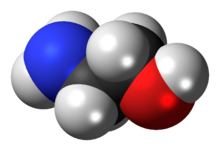Ethanolamine

| ||||

| ||||
| Names | ||||
|---|---|---|---|---|
| Preferred IUPAC name
2-Aminoethan-1-ol[1] | ||||
Other names
| ||||
| Identifiers | ||||
3D model (JSmol)
|
||||
| ChEBI | ||||
| ChEMBL | ||||
| ChemSpider | ||||
| DrugBank | ||||
| ECHA InfoCard | 100.004.986 | |||
| EC Number |
| |||
| KEGG | ||||
PubChem CID
|
||||
| RTECS number |
| |||
| UNII | ||||
CompTox Dashboard (EPA)
|
||||
| ||||
| ||||
| Properties | ||||
| C2H7NO | ||||
| Molar mass | 61.084 g·mol−1 | |||
| Appearance | Viscous colourless liquid | |||
| Odor | Unpleasant ammonia-like odour | |||
| Density | 1.0117 g/cm3 | |||
| Melting point | 10.3 °C (50.5 °F; 283.4 K) | |||
| Boiling point | 170 °C (338 °F; 443 K) | |||
| Miscible | ||||
| Vapor pressure | 64 Pa (20 °C)[2] | |||
| Acidity (pKa) | 9.50[3] | |||
Refractive index (nD)
|
1.4539 (20 °C)[4] | |||
| Hazards | ||||
| GHS labelling: | ||||
| class="wikitable collapsible" style="min-width: 50em;" | ||||
| Pictogram | Code | Symbol description | Image link | |
 |
GHS01 | {{GHS exploding bomb}} | Image:GHS-pictogram-explos.svg | Explosive |
 |
GHS02 | {{GHS flame}} | Image:GHS-pictogram-flamme.svg | |
 |
GHS03 | {{GHS flame over circle}} | Image:GHS-pictogram-rondflam.svg | |
 |
GHS04 | {{GHS gas cylinder}} | Image:GHS-pictogram-bottle.svg | |
 |
GHS05 | {{GHS corrosion}} | Image:GHS-pictogram-acid.svg | Corrosive |
 |
GHS06 | {{GHS skull and crossbones}} | Image:GHS-pictogram-skull.svg | Accute Toxic |
 |
GHS07 | {{GHS exclamation mark}} | Image:GHS-pictogram-exclam.svg | Irritant |
 |
GHS08 | {{GHS health hazard}} | Image:GHS-pictogram-silhouette.svg | Health Hazard |
 |
GHS09 | {{GHS environment}} | Image:GHS-pictogram-pollu.svg | Environment |
See also
- {{H-phrases}}
- {{P-phrases}}
- Category:GHS templates
| Pictogram | Code | Symbol description | Image link | |
|---|---|---|---|---|
 |
GHS01 | {{GHS exploding bomb}} | Image:GHS-pictogram-explos.svg | Explosive |
 |
GHS02 | {{GHS flame}} | Image:GHS-pictogram-flamme.svg | |
 |
GHS03 | {{GHS flame over circle}} | Image:GHS-pictogram-rondflam.svg | |
 |
GHS04 | {{GHS gas cylinder}} | Image:GHS-pictogram-bottle.svg | |
 |
GHS05 | {{GHS corrosion}} | Image:GHS-pictogram-acid.svg | Corrosive |
 |
GHS06 | {{GHS skull and crossbones}} | Image:GHS-pictogram-skull.svg | Accute Toxic |
 |
GHS07 | {{GHS exclamation mark}} | Image:GHS-pictogram-exclam.svg | Irritant |
 |
GHS08 | {{GHS health hazard}} | Image:GHS-pictogram-silhouette.svg | Health Hazard |
 |
GHS09 | {{GHS environment}} | Image:GHS-pictogram-pollu.svg | Environment |
See also
- {{H-phrases}}
- {{P-phrases}}
- Category:GHS templates
|-
|-
| style="padding-left:1em;" |
| Danger
|-
|-
| style="padding-left:1em;" |
| H302, H312, H314, H332, H335, H412[5]
|-
|-
| style="padding-left:1em;" |
| P261, P273, P303+P361+P353, P305+P351+P338[5]
|- | NFPA 704 (fire diamond)
|
|- | Flash point | 85 °C (185 °F; 358 K) (closed cup)
|-
|
| 410 °C (770 °F; 683 K)
|- | Explosive limits | 5.5–17% |-
| colspan=2 style="text-align:left; background-color:#eaeaea;" | Lethal dose or concentration (LD, LC): |-
|-
| style="padding-left:1em;" |
|
- 3320 mg/kg (rat, oral)
- 620 mg/kg (guinea pig, oral)
- 2050 mg/kg (rat, oral)
- 1475 mg/kg (mouse, oral)
- 1000 mg/kg (rabbit, oral)
- 700 mg/kg (mouse, oral)
- 1720–1970 mg/kg (rat, oral)[8]
|-
|- | colspan=2 style="text-align:left; background-color:#eaeaea;" | NIOSH (US health exposure limits): |-
|-
| style="padding-left:1em;" |
| TWA: 3 ppm (6 mg/m3)[7]
|-
|-
| style="padding-left:1em;" |
|
- TWA: 3 ppm (8 mg/m3)
- ST: 6 ppm (15 mg/m3)[7]
|-
|-
| style="padding-left:1em;" |
| 30 ppm[7]
|-
|- | Safety data sheet (SDS) | Sigma[5] |- ! colspan=2 style="background: #f8eaba; text-align: center;" |Related compounds
|-
|
|
|-
| colspan=2 style="text-align:left; background:#f8eaba; border:1px solid #a2a9b1;" |
|-
|}
Ethanolamine (2-aminoethanol, monoethanolamine, ETA, or MEA) is an organic chemical compound with the formula HOCH2CH2NH2. The molecule is bifunctional, containing both a primary amine and a primary alcohol. Ethanolamine is a colorless, viscous liquid with an odor reminiscent to that of ammonia.[9] Its derivatives are widespread in nature; e.g., lipids.
The ethanolamines comprise a group of amino alcohols. A class of antihistamines is identified as ethanolamines, which includes carbinoxamine, clemastine, dimenhydrinate, diphenhydramine, and doxylamine.[10]
Industrial production
Monoethanolamine is produced by treating ethylene oxide with aqueous ammonia; the reaction also produces diethanolamine and triethanolamine. The ratio of the products can be controlled by the stoichiometry of the reactants.[11]
Biochemistry
Ethanolamine is biosynthesized by decarboxylation of serine:[12]
- HOCH2CH(CO2H)NH2 → HOCH2CH2NH2 + CO2
Ethanolamine is the second-most-abundant head group for phospholipids, substances found in biological membranes (particularly those of prokaryotes); e.g., phosphatidylethanolamine. It is also used in messenger molecules such as palmitoylethanolamide, which has an effect on CB1 receptors.[13]
Applications
Ethanolamine is commonly called monoethanolamine or MEA in order to be distinguished from diethanolamine (DEA) and triethanolamine (TEA). It is used as feedstock in the production of detergents, emulsifiers, polishes, pharmaceuticals, corrosion inhibitors, chemical intermediates.[9]
Gas stream scrubbing
Like other amines, monoethanolamine is a weak base and this property is exploited in its use in gas scrubbing.
Aqueous solutions of MEA (solutions of MEA in water) are used as a gas stream scrubbing liquid in amine treaters. For example, aqueous MEA is used to remove carbon dioxide (CO2) and H2S from various gas streams; e.g., flue gas and sour natural gas.[14] The MEA ionizes dissolved acidic compounds, making them polar and considerably more soluble.
MEA scrubbing solutions can be recycled through a regeneration unit. When heated MEA, being rather weak base, will release dissolved H2S or CO2 gas resulting in a pure MEA solution. [11][15] For example, reacting ethanolamine with ammonia gives ethylenediamine, a precursor of the commonly used chelating agent, EDTA :[11]
Other uses
In pharmaceutical formulations, MEA is used primarily for buffering or preparation of emulsions. MEA can be used as pH regulator in cosmetics.[16]
It is also an injectable sclerosant as a treatment option of symptomatic hemorrhoids. 2-5 ml of ethanolamine oleate can be injected into the mucosa just above the hemorrhoids to cause ulceration and mucosal fixation thus preventing hemorrhoids from descending out of the anal canal.
pH-control amine
Ethanolamine is often used for alkalinization of water in steam cycles of power plants, including nuclear power plants with pressurized water reactors. This alkalinization is performed to control corrosion of metal components. ETA (or sometimes a similar organic amine; e.g., morpholine) is selected because it does not accumulate in steam generators (boilers) and crevices due to its volatility, but rather distributes relatively uniformly throughout the entire steam cycle. In such application, ETA is a key ingredient of so-called "all-volatile treatment" of water (AVT).[citation needed]
References
- ^ a b Nomenclature of Organic Chemistry : IUPAC Recommendations and Preferred Names 2013 (Blue Book). Cambridge: The Royal Society of Chemistry. 2014. pp. 649, 717. doi:10.1039/9781849733069-FP001. ISBN 978-0-85404-182-4.
For example, the name 'ethanolamine', which is still widely used, is badly constructed because of the presence of two suffixes; it is not an alternative to the preferred IUPAC name, '2-aminoethan-1-ol'.
- ^ "Ethanolamine MSDS" (PDF). Acros Organics. Archived from the original (PDF) on 2011-07-15.
{{cite web}}: Unknown parameter|deadurl=ignored (|url-status=suggested) (help) - ^ Hall, H.K., J. Am. Chem. Soc., 1957, 79, 5441.
- ^ R. E. Reitmeier; V. Sivertz; H. V. Tartar (1940). "Some Properties of Monoethanolamine and its Aqueous Solutions". Journal of the American Chemical Society. 62 (8): 1943–1944. doi:10.1021/ja01865a009.
- ^ a b c Sigma-Aldrich Co., Ethanolamine. Retrieved on 2018-05-24.
- ^ a b "Globally Harmonized System of Classification and Labelling of Chemicals" (pdf). 2021. Annex 3: Codification of Statements and Pictograms (pp 268–385).
- ^ a b c NIOSH Pocket Guide to Chemical Hazards. "#0256". National Institute for Occupational Safety and Health (NIOSH).
- ^ "Ethanolamine". Immediately Dangerous to Life or Health Concentrations (IDLH). National Institute for Occupational Safety and Health (NIOSH).
- ^ a b "Ethanolamines and Propanolamines". Ullmann's Encyclopedia of Industrial Chemistry. Weinheim: Wiley-VCH. 2002. doi:10.1002/14356007.a10_001.
{{cite encyclopedia}}: Unknown parameter|authors=ignored (help) - ^ Cough, Cold, and Allergy Preparation Toxicity at eMedicine
- ^ a b c Klaus Weissermel; Hans-Jürgen Arpe; Charlet R. Lindley; Stephen Hawkins (2003). "Chap. 7. Oxidation Products of Ethylene". Industrial Organic Chemistry. Wiley-VCH. pp. 159–161. ISBN 3-527-30578-5.
- ^ http://lipidlibrary.aocs.org/Lipids/pe/index.htm
- ^ Calignano, A; La Rana, G; Piomelli, D (2001). "Antinociceptive activity of the endogenous fatty acid amide, palmitylethanolamide". European Journal of Pharmacology. 419 (2–3): 191–8. doi:10.1016/S0014-2999(01)00988-8. PMID 11426841.
- ^ http://www.nap.edu/openbook.php?record_id=11170[full citation needed]
- ^ "Ethanolamine". Occupational Safety & Health Administration.
- ^ Carrasco, F. (2009). "Ingredientes Cosméticos". Diccionario de Ingredientes Cosméticos 4ª Ed. www.imagenpersonal.net. p. 306. ISBN 978-84-613-4979-1.



